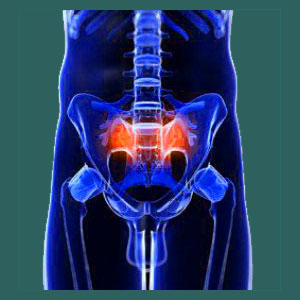
What causes sacroiliac pain? What structural changes might show up on imaging studies, yet not adequately explain pain? These are crucial and related questions that must be answered by all patients who suspect that they are suffering with SIJ symptomology or have been told that their sacroiliac is painful by a doctor.
The sacroiliac joint varies in normal structural and functional presentation from individual to individual. Worse still, the sacroiliac joint changes throughout life in response to various anatomical occurrences, particularly in women. It is important to know that virtually all sacroiliac joint pain diagnoses have some degree of subjectivity to them, while many are completely subjective and not based on any solid and verifiable evidence.
This essay details the causes of sacroiliac joint pain and provides some objective information about the frequent misdiagnosis of SIJ and regional pain conditions for the benefit of all chronic pain sufferers.
What Causes Sacroiliac Pain to Occur?
Sacroiliac joint pain symptoms can be blamed on a variety of diagnoses involving the skeletal joint, as well as the soft tissues that hold the joint together and regulate its range of motion. Pain can be blamed on injury, degeneration, imbalance, systemic hormonal changes, inflammation, disease processes, idiopathic factors and other explanations, making the SI joint a complex structure to accurately evaluate.
Causative theories of pain might involve congenital or developmental abnormality of the joint structures involving the bones of the sacrum or pelvic ilium, as well as similar abnormalities of the soft tissues regulating the joint.
Pain might be caused by trauma to the joint due to injury, surgery or childbirth.
SI Joint inflammation might have known or unknown origins.
Degeneration of the sacroiliac joint components might be blamed for causing pain in some patients, even tough SIJ degeneration is a universally-observed occurrence in all adult humans. This is very similar to the way spinal degeneration is blamed for causing all manner of back and neck pain problems, even though these degenerative conditions are completely normal, expected and universal.
Hormonal changes can be transient or permanent and can affect the SIJ, causing it to become painful in some patients. Women demonstrate many regular hormonal changes due to menstruation, pregnancy and birth that directly affect the SIJ.
Sacroiliac joint dysfunction can occur when regulating ligaments in the joint become too tight or too lax. This is one of the most subjective of all diagnostic theories and often proves itself to be unjustified.
Many diseases, and especially autoimmune diseases, attack the SIJ. Disease actions of the joint can be painful and even debilitating.
Our sacroiliac joint pain causes resource section details many of these theories of pain in great detail.
What Causes SIJ Pain and What Does Not?
While the above section demonstrates that many conditions can indeed cause SIJ pain, it does not provide proof that most of these named conditions inherently do cause pain. In fact, diagnostic statistics show that most of the same conditions implicated in causing pain in some individuals exist in identical or even more clinically severe examples in other individuals, yet cause no pain whatsoever. While there are far too many examples to name each and every condition that might be diagnosed in the SIJ, yet innocent of causing pain, here are some of the most frequently observed:
Degeneration of the joint and/or ligaments is normal. The SIJ suffers tremendous strain during normal use and all this wear takes a toll over time. All adults will demonstrate deterioration of the joint components, but few will ever develop pain in the joint, despite the degeneration being very clinically significant in most cases.
Ligmentous tension and laxity ranges greatly from person to person and is in constant flux in most people (all women for sure) based on many factors. Diagnosing SIJ pain based on ligament tension or laxity is often a terrible catastrophe of misdiagnosis.
Some people demonstrate structural atypicalities of the joint faces or skeletal components. There is rarely any evidence that these types of individual structural presentations are pathological in any way, yet many accept blamed for causing pain nonetheless.
What Causes Sacroiliac Pain and How Do You Know for Sure?
Diagnosis of many health issues is subjective and misdiagnosis of all chronic pain syndromes is currently at epidemic levels and continuing to grow in terms of the scope of conditions which are unfairly blamed for causing pain, as well as the number of patients who are misdiagnosed each year. Seeking healthcare has never been more frightening than now. How do you know if your SIJ diagnosis is right or not?
First, we always recommend seeking evaluation for a specialist in the type of pain you are experiencing. If you are having apparent SIJ pain, consult with an orthopedist. This is a good place to start. Once you have an opinion, seek a second opinion and even a third before undergoing any type of treatment. Consider consulting with a physical therapist and a neurologist for the best diversity of educational backgrounds and practice focuses.
Simultaneously, do lots of independent research from non-financially-motivated sources. If an article was written by a doctor who wants to perform surgery on you, or by a product manufacturer that wants you to become a customer, be cautious what and how much you believe. Most of this type of writing is marketing and not research… You can always trust the various sites of The Cure Back Pain Network since we are a chronic pain advocacy group who work for free since 2006.
Finally, if you do agree on a particular diagnosis, be sure to monitor treatment results carefully. Successful treatment is a good indicator of diagnostic accuracy. Failed treatment is often a sign of diagnostic incompetency. So many patients go from doctor to doctor and treatment to treatment, but never even consider to re-evaluate their cause of pain. They accept their original diagnosis as fact, despite all the treatments targeting that condition failing them miserably. This is insanity in its purest form.
Sacroiliac Joint Pain > Sacroiliac Relief > What Causes Sacroiliac Pain?





